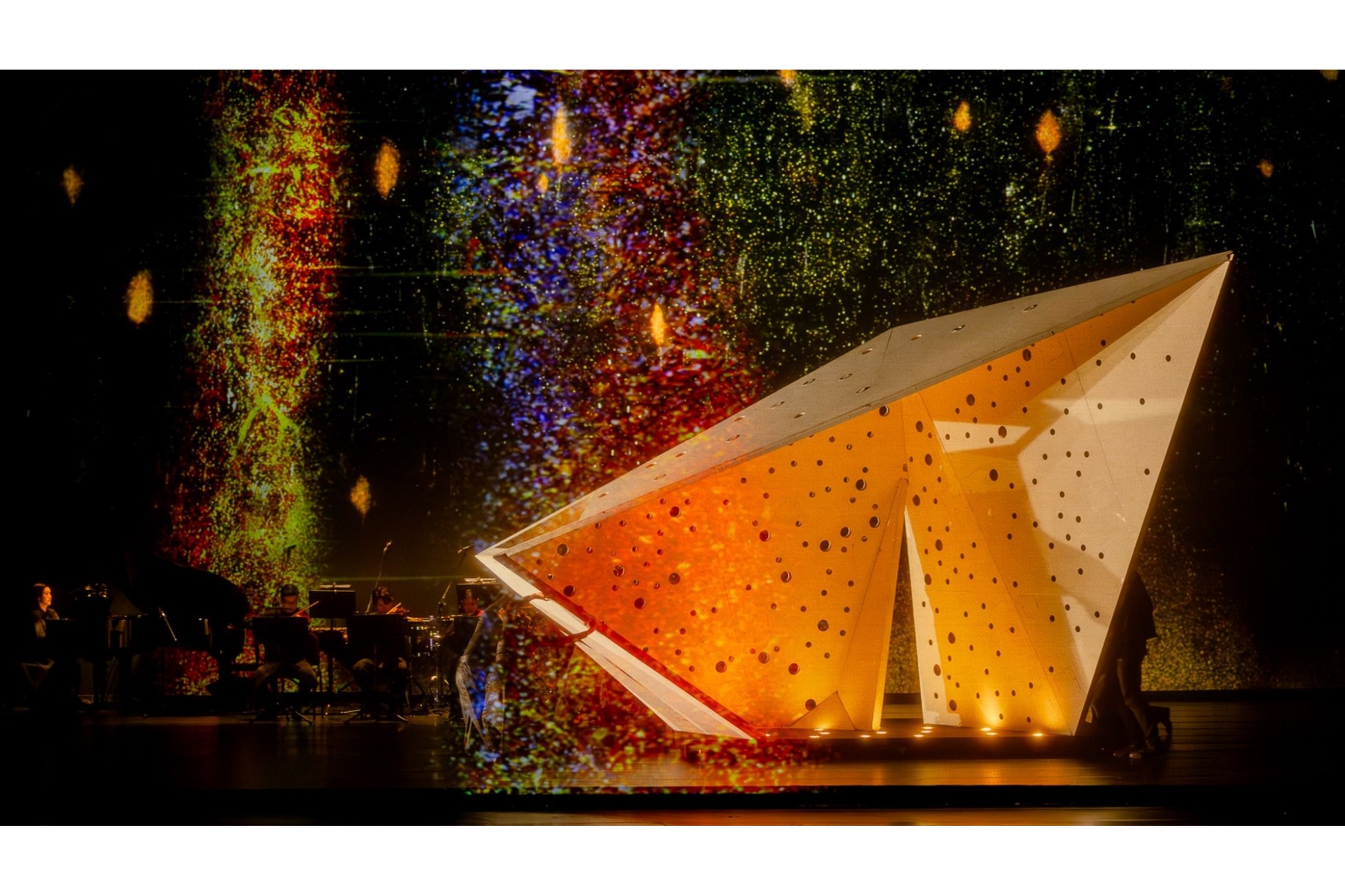
"Pursuing the Light Ahead-Into PAUL CHIANG" draws inspiration from the pivotal works of renowned artist Paul Chiang, who, after 30 years abroad, returned to his hometown, Taiwan. Using works such as "Notre Dame de Paris", "Hundred Year Temple", "Pisilian, “Silver Lake", and his sculptures as creative foundations, this piece explores the dialogue between humanity, nature, spirit, and space, inspired by light. It reflects Chiang’s creative spirit during a time of introspection, capturing an inner light and finding enduring strength and purpose through music. This journey invites reflection on life’s essence and a pursuit of humanistic care.
The project draws inspiration from the sculptural works of artist Paul Chiang. The steel sculpture, "Holy of Holies", is deconstructed into three components: a semi-transparent triangular prism, a semi-transparent folded plate, and a perforated solid plate. Breaking away from traditional static stage design, this setup allows for the disassembly and reassembly of stage elements, transforming them into projection surfaces for a multi-layered, dynamic space. Performers, dancers, and musicians can move freely within, flowing like musical notes. This design captures the interplay of space and time, as if each moment occurs within a shared reality of "music and visuals." The result is an immersive spatial experience that translates Chiang’s art into three dimensions, showcasing extraordinary light and shadow effects. The project embodies Paul Chiang's vision: "All my works attempt to extend outward," bringing to life his multi-layered spatial dynamism and sense of boundless continuity.
The design team hopes the audience will experience a profound connection between light and art through this theatrical performance, sparking a dialogue on the relationship between self and nature, spirit and space. In the "Notre Dame de Paris" scene, the contrast between light and shadow is striking, with the stage setup and dancers' movements perfectly echoing Paul Chiang's exploration of spirituality. His work "Hundred Year Temple" reflects a continuous accumulation, while "Silver Lake" represents an emptiness, a return to silence. In the "Silver Lake" scene, the stage evokes a vast, pure landscape, embodying Chiang’s philosophy: art is a form of purification, a reflection of nature, emptiness, and a sanctuary for the soul.
"Pursuing the Light Ahead" is inspired by Paul Chiang's iconic works, merging sound, visuals, music, and dance to embody his profound interpretation of light. The program unfolds in several segments, each with a distinct artistic expression. Music and dance intertwine, accompanied by multimedia visuals and stage lighting design, creating an immersive theatrical experience that brings Chiang's vision to life on stage. The three components, crafted with varying materials and levels of transparency, create diverse layers on stage. Each component also serves as a performer, dynamically interacting with the dancers. In "Notre Dame de Paris", a semi-transparent triangular prism represents an unknown energy. Suspended in the vastness of space, it symbolizes a spiritual quest between the divine and human self. The perforated folding plate in "Hundred Year Temple" casts light through its holes, evoking the hopeful candlelight often seen in Paul Chiang's works. "Pisilian" juxtaposes solid and void, symbolizing Chiang’s journey from confined spaces (solid) to the boundlessness of nature, illustrating the shift between solid and void, weight and lightness in his art. The reconstructed "Holy of Holies" features projection to continuously alter the sculpture’s form and edges, embodying the concept of blurred boundaries. The process of deconstruction and reassembly mirrors a spiritual journey, where all souls are gathered within the "Holy of Holies" for purification before returning to their own essence, finding peace and stillness within.
Paul Chiang is a renowned artist from Taichung, Taiwan, who spent 30 years abroad before returning to Taiwan to continue his artistic career. Deeply influenced by classical music, his work is imbued with a sense of poetry and spirituality, masterfully using light, shadow, and brushwork to convey his inner world. Chiang believes that art has the power to purify the soul, and he sees the evolution of the human heart as a journey toward finding a place of peace for the spirit. Through his art, he invites viewers to reflect on the relationship between self and nature. His works carry a warmth, with brushstrokes that flow like rhythmic melodies, leaving a lasting impact on the Taiwanese art field. In cross-disciplinary production, achieving a perfect balance between pure artistic expression and technology is a significant challenge. Maintaining the warmth and brushstroke essence of Paul Chiang’s original works, while incorporating the artistic languages of creators from various fields, requires a delicate approach. Known for the unique spirituality in his work, Chiang’s pieces demand that the design team preserve the profound depth of the originals. At the same time, they must introduce innovative artistic expressions through music, stage design, and audiovisual effects—a task that demands skillful integration of technical precision with artistic sensitivity.
Collaboration Team
Neo-Classical Chamber Ensemble
Chao Chien-Ming Architects & Planners
Producer
Chen Hsin-I
Director
Hsieh Chieh-hua
Stage Design
Chao Chien-Ming
Performing Ensemble
Neo-Classical Chamber Ensemble